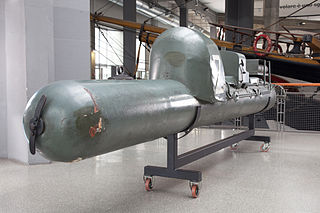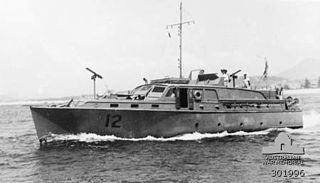
The Type A Ko-hyoteki class was a class of Japanese midget submarines (Kō-hyōteki) used during World War II. They had hull numbers but no names. For simplicity, they are most often referred to by the hull number of the mother submarine. Thus, the midget carried by I-16-class submarine was known as I-16's boat, or "I-16tou."

Port Jackson, commonly known as Sydney Harbour, consists of the waters of Sydney Harbour, Middle Harbour, North Harbour and the Lane Cove and Parramatta Rivers, is the ria or natural harbour of Sydney, New South Wales, Australia. The harbour is an inlet of the Tasman Sea. It is the location of the Sydney Opera House and Sydney Harbour Bridge. The location of the first European settlement and colony on the Australian mainland, Port Jackson has continued to play a key role in the history and development of Sydney.

HMAS AE1 was an E-class submarine of the Royal Australian Navy (RAN). She was the first submarine to serve in the RAN, and sank with all hands near what is now East New Britain, Papua New Guinea, on 14 September 1914, after less than seven months in service. Search missions attempting to locate the wreck began in 1976. The submarine was found during the 13th search mission near the Duke of York Islands in December 2017.

Human torpedoes or manned torpedoes are a type of diver propulsion vehicle on which the diver rides, generally in a seated position behind a fairing. They were used as secret naval weapons in World War II. The basic concept is still in use.

Watsons Bay is a harbourside, eastern suburb of Sydney, in the state of New South Wales, Australia. Watsons Bay is located 11 km north-east of the Sydney central business district, in the local government area of the Municipality of Woollahra.

HMAS Kuttabul, formerly SS Kuttabul, was a Royal Australian Navy depot ship, converted from a Sydney Ferries Limited ferry.

From 31 May to 8 June 1942, during World War II, Imperial Japanese Navy submarines made a series of attacks on the Australian cities of Sydney and Newcastle. On the night of 31 May – 1 June, three Ko-hyoteki-class midget submarines, each with a two-member crew, entered Sydney Harbour, avoided the partially constructed Sydney Harbour anti-submarine boom net, and attempted to sink Allied warships. Two of the midget submarines were detected and attacked before they could engage any Allied vessels. The crew of M-14 scuttled their submarine, whilst M-21 was successfully attacked and sunk. The crew of M-21 killed themselves. These submarines were later recovered by the Allies. The third submarine attempted to torpedo the heavy cruiser USS Chicago, but instead sank the converted ferry HMAS Kuttabul, killing 21 sailors. This midget submarine's fate was unknown until 2006, when amateur scuba divers discovered the wreck off Sydney's northern beaches.

An anti-submarine net or anti-submarine boom is a boom placed across the mouth of a harbour or a strait for protection against submarines. Net laying ships would be used to place and remove the nets. The US Navy used anti-submarine nets in the Pacific War to protect major US Naval Advance Bases. Some net cutter submarines were used in the war.
The Lake Macquarie anti-submarine boom was a submarine and small boat defence boom located at the entrance to Lake Macquarie, New South Wales, Australia during World War II.

Fort Lytton is a heritage-listed 19th century coastal fort in the suburb of Lytton in Brisbane, Queensland, Australia. The name “Fort Lytton” is also used to describe the 1 square mile (2.6 km2) military base that surrounded the fort. Fort Lytton was built in 1880–1882, and operated until 1965. The historic fort is now contained in Fort Lytton National Park. The park is open to the public on most Sundays and public holidays. Guided tours are provided by Fort Lytton Historical Association, a non-profit volunteer organisation.

Yandra was a 990-ton coastal steamer built by Burmeister & Wain, Copenhagen in 1928 for Coast Steamships for service in the Australian state of South Australia. She was requisitioned by the Royal Australian Navy in June 1940 during World War II for conversion to a minesweeper and anti-submarine vessel and was commissioned on 22 September 1940 as HMAS Yandra. She returned to civilian service in 1946. She ran aground during dense fog onto South Neptune Island on 25 January 1959 and was subsequently written off.

HMAS Yarroma was formerly a luxury motor cruiser, commissioned as a channel patrol boat operated by the Royal Australian Navy (RAN) during the Second World War. She was one of thirteen similar vessels, known to Sydneysiders as the 'Hollywood Fleet'.
HMAS Toomaree was formerly a luxury motor cruiser, commissioned as a channel patrol boat and operated by the Royal Australian Navy (RAN) during World War II. She was one of thirteen similar vessels, known to Sydneysiders as the 'Hollywood Fleet'.
HMAS Seamist (10) was formerly a Sydney-based luxury motor cruiser, commissioned as a channel patrol boat into and operated by the Royal Australian Navy (RAN) during World War II. She was one of thirteen similar vessels, known to Sydney siders as the 'Hollywood Fleet'.
HMAS Silver Cloud (52) was a luxury motor cruiser, commissioned as a channel patrol boat operated by the Royal Australian Navy (RAN) during World War II. She was one of thirteen similar vessels, known to Sydneysiders as the 'Hollywood Fleet'.

HMAS Steady Hour (12) was formerly a luxury motor cruiser, commissioned as a channel patrol boat and operated by the Royal Australian Navy (RAN) during the Second World War. She was one of thirteen similar vessels, known to Sydney siders as the 'Hollywood Fleet'.

HMAS Marlean (Q20) was a channel patrol boat commissioned into and operated by the Royal Australian Navy (RAN) during World War II. She was one of thirteen similar vessels, known to Sydney siders as the 'Hollywood Fleet'.

HMAS Nereus (19) was formerly a luxury motor cruiser, commissioned as a channel patrol boat operated by the Royal Australian Navy (RAN) during the Second World War. She was one of thirteen similar vessels, known to Sydneysiders as the 'Hollywood Fleet'.
M24 Japanese Midget Submarine wreck site is a heritage-listed former midget submarine and now archaeological site located in unincorporated waters off Sydney's Northern Beaches in New South Wales, Australia. The Ko-hyoteki-class midget submarine was designed by the Imperial Japanese Navy and built from 1941 to 1942 by Kure Naval Yard or Ourazaki Naval Yard. The site was added to the New South Wales State Heritage Register on 7 December 2007.

HMAS Lolita (14) was formerly a luxury motor cruiser, commissioned as a channel patrol boat into and operated by the Royal Australian Navy (RAN) during World War II. She was one of thirteen similar vessels, known to Sydney siders as the 'Hollywood Fleet'.



















